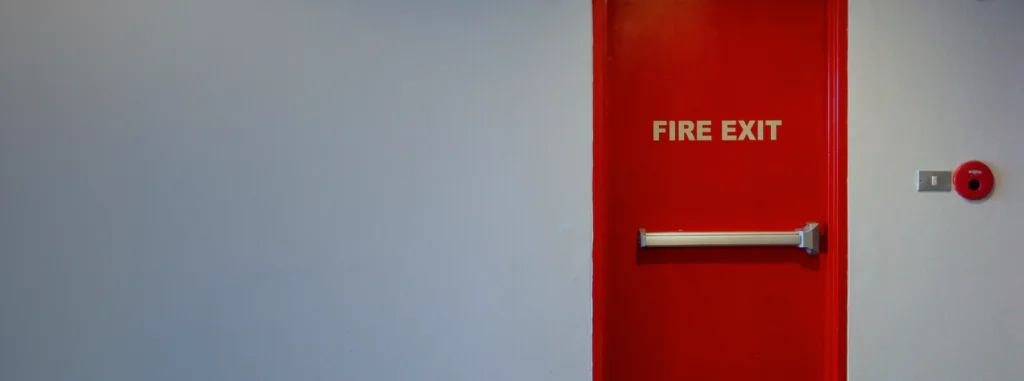The Importance of Fire Doors
Fire doors are a crucial part of any building’s fire safety plan because they are specifically designed to contain fires, reduce the spread of smoke, and protect escape routes. This helps to give building occupants sufficient time to exit the building safely.
Why are fire doors essential?
Containment of fire and smoke
- Slows Fire Spread – they are made of materials that can resist high temperatures and flames for a specific time (between 30-120 minutes). This prevents the fire from quickly spreading through a building.
- Limits Smoke Spread – they are typically equipped with seals that expand when exposed to heat, sealing gaps to keep smoke from moving freely between rooms.
Protection of escape routes
- Safe Exits for Occupants – By preventing the spread of fire and smoke into escape routes such as stairwells and corridors, fire doors keep escape routes clear and safe for occupants to safely escape a building.
- Time for Evacuation and Emergency Response – they are crucial in slowing down fire and smoke. This provides time for occupants to escape and for the fire and rescue service to arrive and contain the fire.
Reducing damage to property
- Minimizing Fire Damage – Fire doors can keep a fire contained and protect personal property and the building, limiting the damage caused by a fire.
- Protects Important Spaces – Fire doors can protect areas such as storage areas or server rooms which can protect against sufficient loss and production downtime.
Safety for Vulnerable Occupants
- Special Considerations for At-Risk Individuals – In buildings such as care homes, fire doors are very important because they protect people who may be more vulnerable or require assistance to escape the building.
Maintenance and Usage
- Routine Checks and Compliance – To ensure fire doors remain effective, they must be checked and maintained regularly. Any damage should be dealt with as soon as possible.
- Correct usage – Fire doors can only work effectively when they are closed. They shouldn’t be kept wedged open and should have sufficient self-closing mechanisms fitted.
Important Inspections for Fire Doors
- Door and frame condition – Inspectors look for damage such as warping, holes or cracks.
- Seal and edge integrity – Intumescent seals that expand with heat must be in good condition with no signs of wear or gaps.
- Gaps – The gaps between the fire door and frame shouldn’t be larger than 4mm along the top and sides, and as small as possible at the bottom.
- Opening and closing – A fire door should open and close easily without sticking or requiring extra force.
- Hinges and screws – Steel hinges must be firmly attached and no missing or loose screws.
- Latches and closures – Fire doors must have a sufficiently working latch so they remain closed under the force of a fire. A self-closing mechanism is essential to make sure fire door automatically close after being opened.
- Hold open mechanisms – Hold open mechanisms allow a fire door to be kept open, but automatically close when a fire alarm sounds.
- Fire door signage – they should have clear fire door signage and indicate that they must be kept closed.
- Ratings – Rating labels should be fitted to each fire door indicating its fire resistance rating, ranging from 30-120 minutes.
- Fire-rated glass – Some include windows or vision panels, which should be made from fire resistance glass.
- Glazing seals – The glass should be firmly sealed to ensure smoke and fire resistance.
- Seal expansion tests – Many fire doors have smoke seals that expand in response to heat, sealing the edges to prevent smoke from passing through.
- Buildings higher than 11m – Communal fire doors must be checked every 3 months. Flat entrance doors must be checked every 12 months.
- Record keeping – All inspections must be correctly documented including any actions required.
Common Issues Found in Fire Door Inspections
- Blocked or wedged-open fire doors.
- Damaged or missing self-closing devices.
- Gaps or misalignment issues that allow smoke and fire to pass through.
- Damaged seals or missing intumescent strips.
- Improper or non-compliant signage.
Inadequate fire doors can lead to incidents that may result in physical injury or property damage. HPC provides a wide range of fire safety services including door inspections.
To find out more information or if your business requires a fire door inspection please get in contact with our team of experts.
T: 0330 107 1037
E: contact@hpc.uk.com
LinkedIn: High Performance Consultancy
